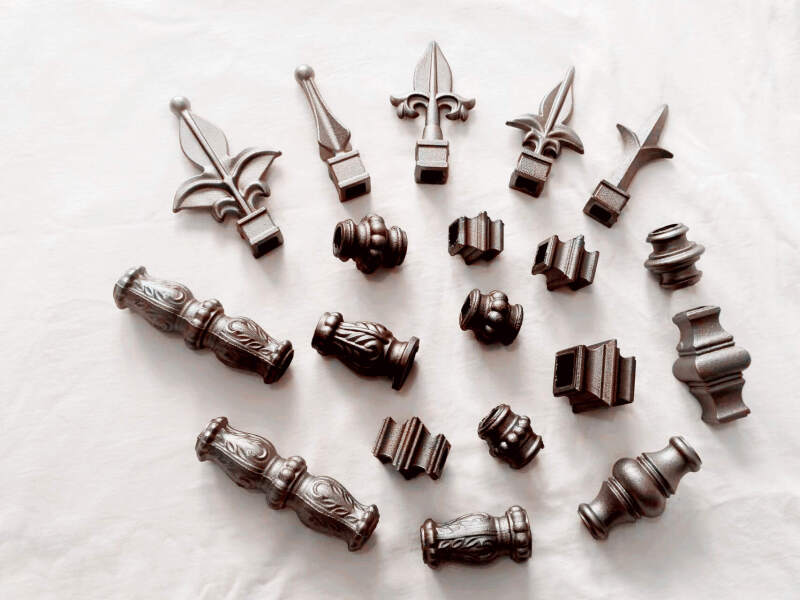
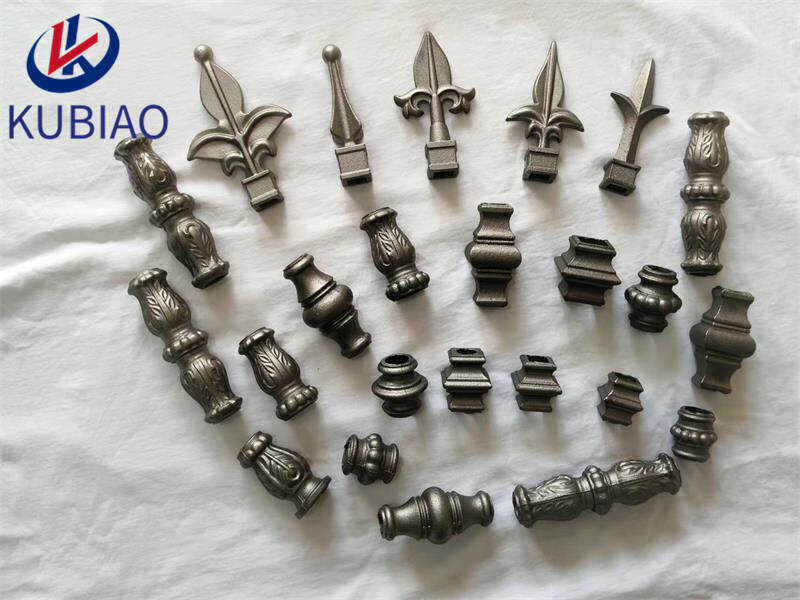
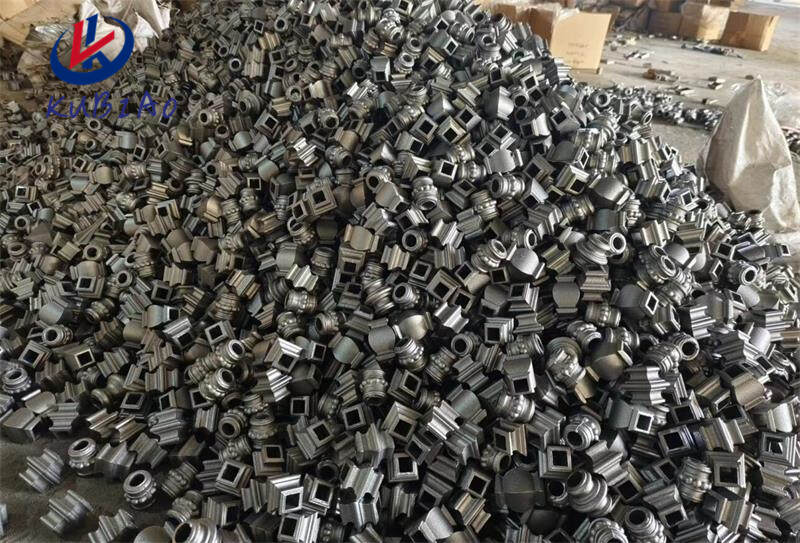
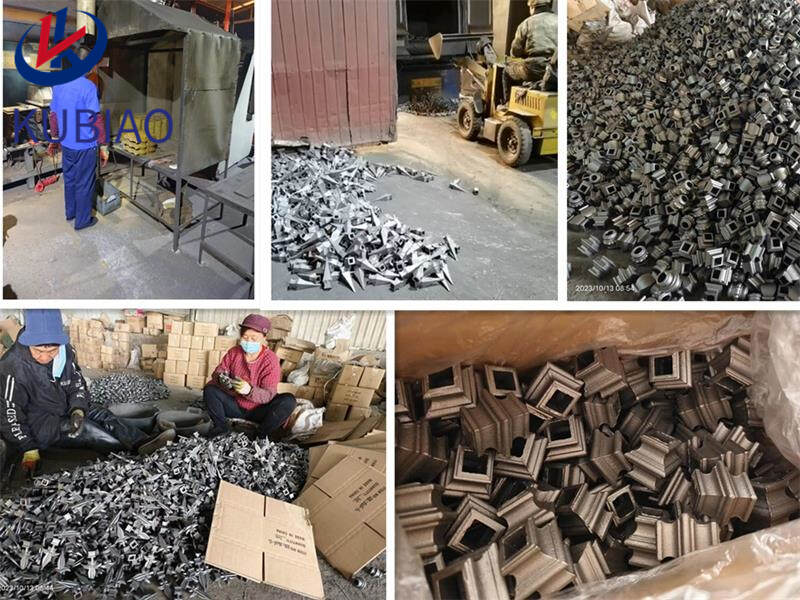
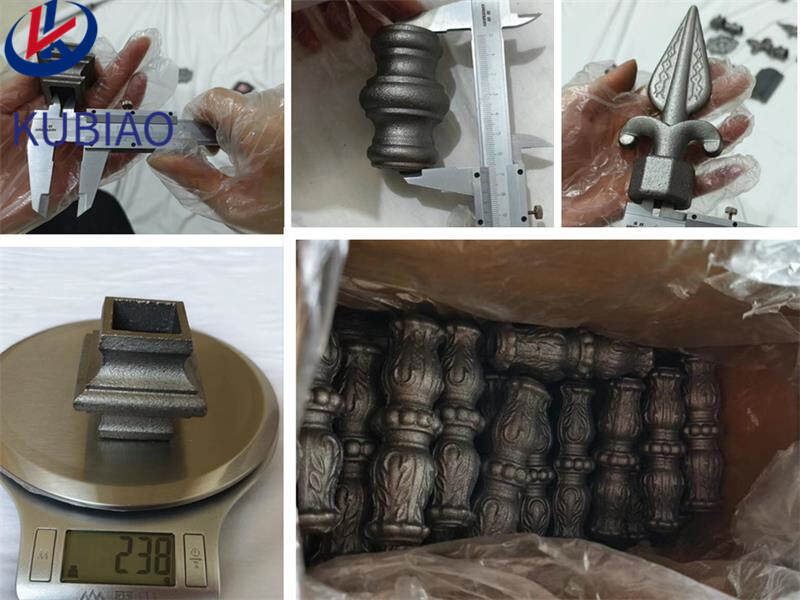
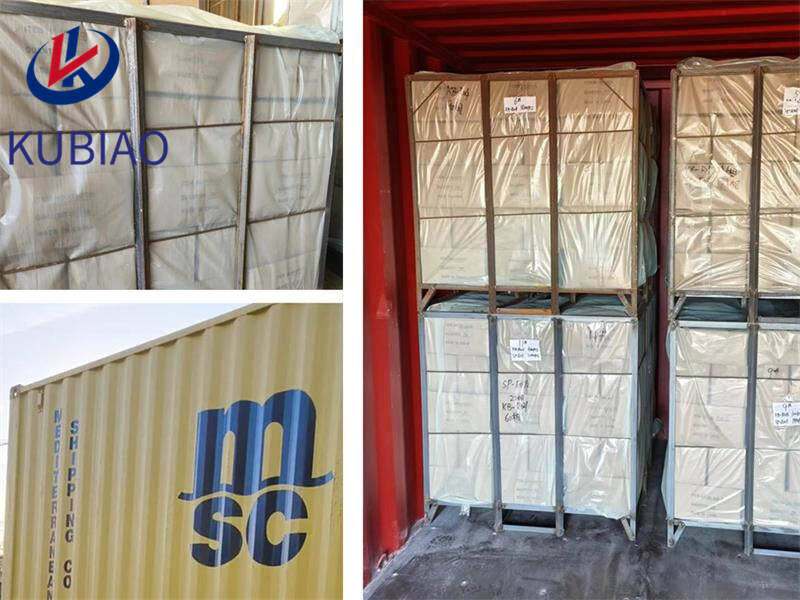
| Product name | iron decor |
| Keyword | cast iron ornamental fence parts ,cast iron garden ornaments,cast iron spear,cast iron fairy garden ornament,customized casting ,cast iron fence collar ,ornamental iron |
| Place of Origin | China |
| Quality standard | We have our own professional QC team to insure the quality. |
| Feature | Cast iron is a strong metal material that can withstand large amounts of pressure and weight. It is also durable and resistant to corrosion, making it ideal as a decorative item |
| Application scope | Courtyard, etc. |
| surface treatment | sand blasting antirust antirust oil/water painting hot dip galvanizing |
| Unit Weight(g) | 210(Contact us for specific information to confirm) |
| terms of payment | 50% T/T in advance, balance before shipment. |
| Life span | 16 years (Contact us for specific information to confirm) |
| delivery time | It usually takes 40 days. |
| Advantage | We keep good quality and competitive price to ensure our customers benefit |
| Packing | 14x11.73x14cm(Contact us for specific information to confirm) |
| OEM/ODM | Customization Service Provided |
| design | beautiful elegance sleek pretty |
| Sales country | All over the world for example:Montserrat,Antarctica,Colombia,Monaco,Lithuania,Turkmenistan,Ethiopia |
| MOQ | 263pcs(Contact us for specific information to confirm) |
1.Are there any famous examples of iron decor in famous buildings?
We have established long-term and stable partnerships with our suppliers, so we have great advantages in price and cost and quality assurance.
1. Eiffel Tower - The iconic Parisian landmark features cast iron ornaments in its intricate lattice design.
2. Grand Central Terminal - The main concourse of this New York City train station is adorned with cast iron chandeliers and decorative elements.
3. Buckingham Palace - The gates and railings of the royal residence in London are made of cast iron, featuring ornate designs and crests.
4. St. Pancras Station - This Victorian railway station in London is known for its elaborate cast iron roof and decorative elements.
5. New York Public Library - The main branch of the NYPL features cast iron lamp posts and decorative grilles on its exterior.
6. The Palace of Westminster - The Houses of Parliament in London feature cast iron elements, including the iconic Big Ben clock tower.
7. The Iron Bridge - This 18th century bridge in Shropshire, England is considered a masterpiece of cast iron engineering and design.
8. The Smithsonian Castle - The oldest building on the National Mall in Washington D.C. features cast iron columns and decorative elements.
9. The Royal Albert Hall - This concert hall in London features a cast iron dome and decorative friezes on its exterior.
10. The Flatiron Building - This iconic New York City skyscraper is known for its unique triangular shape and cast iron facade.
2.How long do iron decor typically last?
We attach importance to the innovation ability and team spirit of employees, have advanced R & D facilities and laboratories, and have a good quality management system.
Cast iron ornaments can last for decades or even centuries if they are properly cared for and maintained. However, their lifespan can vary depending on factors such as exposure to harsh weather conditions, regular cleaning and maintenance, and the quality of the cast iron itself. With proper care, cast iron ornaments can last for generations.
3.Are there any DIY techniques for creating my own iron decor ?
We have a good reputation and image in the industry. The quality and price advantage of iron decor products is an important factor in our hard overseas market.
1. Sand Casting: This method involves creating a mold using sand and pouring molten cast iron into it. You can use a wooden pattern or a 3D printed mold to create intricate designs. Once the iron has cooled and solidified, the sand can be removed to reveal the ornament.
2. Clay Casting: Similar to sand casting, this method involves creating a mold using clay instead of sand. The clay can be molded into any shape or design and then coated with a layer of sand before pouring in the molten iron. Once cooled, the clay can be removed to reveal the ornament.
3. Lost Wax Casting: This technique involves creating a wax model of the ornament and then coating it with a layer of ceramic. The wax is then melted out, leaving a hollow ceramic mold. Molten iron is then poured into the mold and once cooled, the ceramic can be broken away to reveal the ornament.
4. Repurposed Molds: You can also use existing objects such as cookie cutters, silicone molds, or even household items like bottle caps or keys to create unique cast iron ornaments. Simply pour the molten iron into the mold and let it cool before removing the ornament.
5. Sandpaper Etching: If you don't have access to molten iron, you can still create a cast iron look by using sandpaper to etch designs onto a piece of metal. You can then paint the metal with a rust-colored paint to give it an aged look.
6. Welding: If you have some welding skills, you can create your own cast iron ornaments by welding together pieces of scrap metal. You can use a grinder to smooth out any rough edges and give it a more polished look.
7. 3D Printing: If you have access to a 3D printer, you can design and print your own cast iron ornaments using a special filament that contains iron particles. Once printed, the ornament can be heated to fuse the iron particles together, giving it a cast iron appearance.
Remember to always take proper safety precautions when working with molten iron or welding equipment. It is also important to properly dispose of any leftover materials and follow local regulations for metalworking.
4.Are there any cultural or symbolic meanings behind certain cast iron ornament designs?
We actively participate in the iron decor industry associations and organization activities. The corporate social responsibility performed well, and the focus of brand building and promotion
Yes, there are several cultural and symbolic meanings associated with certain cast iron ornament designs. Some common examples include:
1. Fleur-de-lis: This symbol, which resembles a stylized lily or iris, is often associated with French culture and royalty. It is also used as a symbol of purity, light, and life.
2. Celtic Knots: These intricate designs, often seen in Celtic and Irish cultures, symbolize eternity, continuity, and interconnectedness.
3. Dragon: In many Asian cultures, dragons are seen as powerful and auspicious creatures, representing strength, wisdom, and good luck.
4. Sunburst: This design, featuring rays of light emanating from a central point, is often associated with the sun and its life-giving properties. It can also symbolize enlightenment and spiritual growth.
5. Pineapple: In Western cultures, the pineapple is often seen as a symbol of hospitality, warmth, and welcome.
6. Tree of Life: This design, featuring a tree with spreading branches and deep roots, is a common symbol in many cultures, representing the interconnectedness of all living things and the cycle of life.
7. Anchor: In maritime cultures, the anchor is a symbol of stability, strength, and hope.
8. Cross: The cross, a symbol of Christianity, is often seen in cast iron designs and can represent faith, sacrifice, and redemption.
9. Horseshoe: In many cultures, the horseshoe is seen as a symbol of good luck and protection.
10. Star of David: This six-pointed star is a symbol of Judaism and can represent unity, balance, and divine protection.
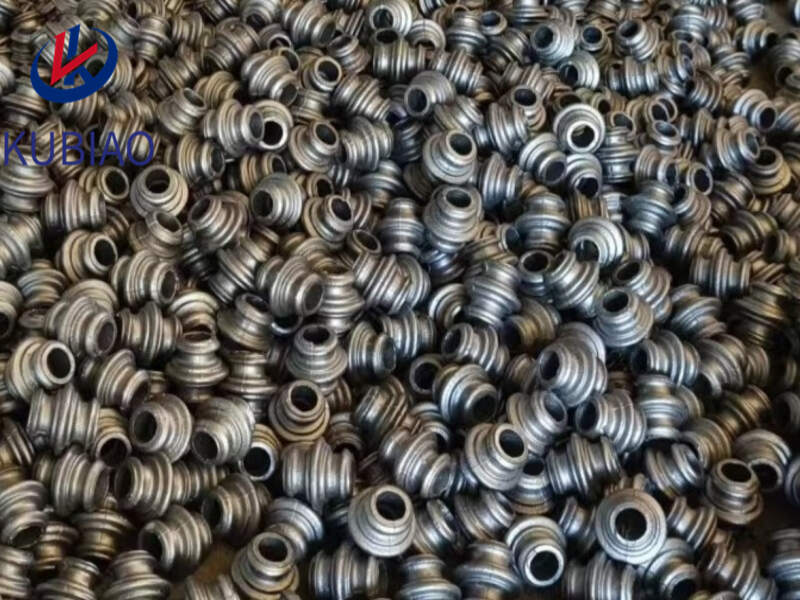
5.What are the differences between iron decor and other metal decorations?
We have advantages in marketing and channel expansion. Suppliers have established good cooperative relations, continuously improved workflows, improved efficiency and productivity, and provided customers with high -quality products and services.
1. Material: The main difference between cast iron ornaments and other metal decorations is the material used. Cast iron ornaments are made from iron that has been melted and poured into a mold, while other metal decorations can be made from a variety of metals such as aluminum, brass, copper, or steel.
2. Weight: Cast iron ornaments are typically heavier than other metal decorations due to the density of iron. This can make them more durable and less likely to be blown over by strong winds.
3. Strength: Cast iron is known for its strength and durability, making cast iron ornaments more resistant to damage and wear compared to other metal decorations.
4. Rust resistance: Cast iron is prone to rusting, so cast iron ornaments may require regular maintenance to prevent rust. Other metal decorations, such as aluminum or stainless steel, are more resistant to rust and may require less maintenance.
5. Design options: Cast iron ornaments are limited in terms of design options due to the casting process. Other metal decorations can be formed into more intricate and detailed designs using techniques such as welding, bending, and cutting.
6. Cost: Cast iron ornaments tend to be more expensive than other metal decorations due to the cost of the materials and the labor-intensive casting process.
7. Versatility: Other metal decorations can be used both indoors and outdoors, while cast iron ornaments are primarily used for outdoor decor due to their weight and rust-prone nature.
8. Historical significance: Cast iron has been used for centuries in architectural and decorative elements, giving cast iron ornaments a sense of history and tradition that other metal decorations may not have.
6.What are the differences between antique and new iron decor ?
We continuously upgrade our skills and knowledge to adapt to changing iron decor market needs.
1. Age: The most obvious difference between antique and new cast iron ornaments is their age. Antique cast iron ornaments are typically at least 100 years old, while new ones are recently manufactured.
2. Design: Antique cast iron ornaments often have intricate and detailed designs, reflecting the craftsmanship of the time period they were made in. New cast iron ornaments may have simpler and more modern designs.
3. Rarity: Due to their age, antique cast iron ornaments are often more rare and harder to find than new ones. This can make them more valuable to collectors.
4. Quality: Antique cast iron ornaments were often made with high-quality materials and craftsmanship, resulting in a more durable and long-lasting product. New cast iron ornaments may not have the same level of quality and may be more prone to damage.
5. Patina: Antique cast iron ornaments have a natural patina that develops over time, giving them a unique and aged appearance. New cast iron ornaments may lack this patina and may look more uniform and shiny.
6. Price: Due to their rarity and historical value, antique cast iron ornaments can be more expensive than new ones. New cast iron ornaments are often more affordable and readily available.
7. Authenticity: Antique cast iron ornaments have a sense of authenticity and history that cannot be replicated in new ones. They have a story and a connection to the past that adds to their charm and value.
8. Collectibility: Antique cast iron ornaments are highly sought after by collectors, making them a valuable and desirable item. New cast iron ornaments may not hold the same level of collectibility.
9. Condition: Antique cast iron ornaments may have some wear and tear due to their age, while new ones are in pristine condition. This can affect their appearance and value.
10. Purpose: Antique cast iron ornaments were often used for practical purposes, such as architectural details or garden decorations. New cast iron ornaments may be more decorative and used solely for aesthetic purposes.
7.What are some common misconceptions about iron decor ?
Being one of the top iron decor manufacturers in China, We attach great importance to this detail.
1. They are fragile: Many people assume that cast iron ornaments are delicate and can easily break. However, cast iron is a strong and durable material that can withstand harsh weather conditions and heavy use.
2. They are expensive: While some cast iron ornaments may be pricey, there are also many affordable options available. Additionally, their durability and longevity make them a cost-effective choice in the long run.
3. They are only suitable for traditional or rustic styles: Cast iron ornaments are often associated with traditional or rustic decor, but they can also add a touch of elegance and sophistication to modern or contemporary spaces.
4. They are difficult to maintain: Some people believe that cast iron ornaments require a lot of maintenance and upkeep. However, with proper care and occasional cleaning, they can last for many years without any issues.
5. They are all the same: Cast iron ornaments come in a variety of designs, sizes, and finishes. They can be intricately detailed or simple and sleek, making them suitable for different styles and preferences.
6. They are only for outdoor use: While cast iron ornaments are commonly used in outdoor spaces, they can also be used indoors to add a unique and decorative touch to any room.
7. They are heavy and difficult to install: While cast iron ornaments can be heavy, they are not necessarily difficult to install. Many come with mounting hardware or can be easily hung with screws or nails.
8. They are only for decorative purposes: While cast iron ornaments are often used for decorative purposes, they can also serve functional purposes such as supporting plants or serving as bookends.
9. They are prone to rust: While cast iron can rust if not properly cared for, many modern cast iron ornaments are coated with a protective finish to prevent rusting.
10. They are outdated: Cast iron ornaments have been used for centuries and have stood the test of time. They continue to be a popular choice for home decor, making them far from outdated.
8.What colors can iron decor come in?
As one of the top iron decor manufacturers in China, we take this very seriously.
Cast iron ornaments can come in a variety of colors, including:
1. Black: This is the most common color for cast iron ornaments, as it is the natural color of the material.
2. Bronze: Cast iron can be treated with a bronze finish to give it a warm, metallic look.
3. White: Some cast iron ornaments may be painted white for a more modern or shabby chic look.
4. Rust: Over time, cast iron can develop a rust patina, giving it a unique and aged appearance.
5. Green: Some cast iron ornaments may be painted green for a vintage or antique look.
6. Gold: Cast iron can be treated with a gold finish for a luxurious and elegant look.
7. Silver: Similar to gold, cast iron can also be treated with a silver finish for a more modern and sleek appearance.
8. Blue: Some cast iron ornaments may be painted blue for a pop of color and a whimsical touch.
9. Red: Red is another popular color for cast iron ornaments, especially during the holiday season.
10. Custom colors: Cast iron ornaments can also be painted or coated in any custom color to match a specific theme or decor.
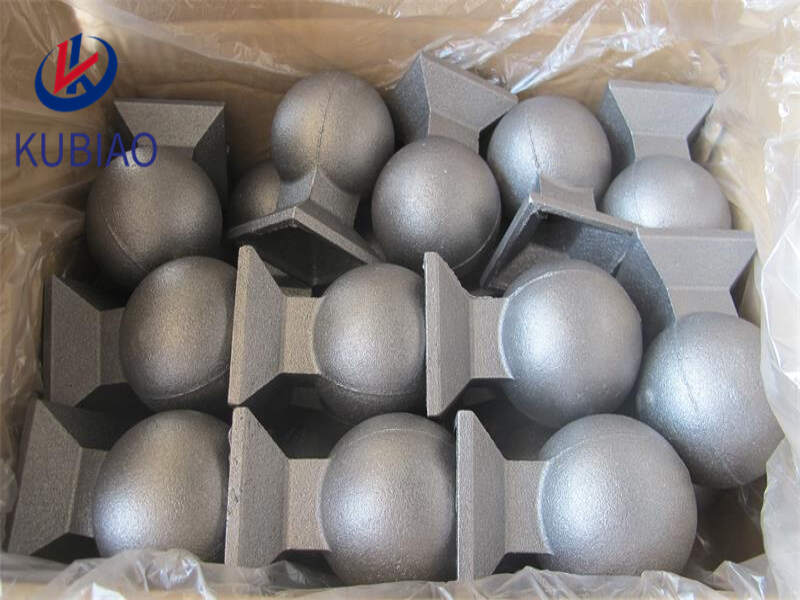
Welcome to contact us for Cast Iron Order!
Email: sales@kubiaometal.com
Cellphone/Whatsapp: 0086 13020588163
Wechat: 13028588163
Tag:cast iron fence post caps,cast iron collar,cast iron fence decorations,cast iron fence caps,antique cast iron fence finials,iron gate parts ,cast iron leaf,fence decorative collar
PREV: iron decor parts
Product
Category